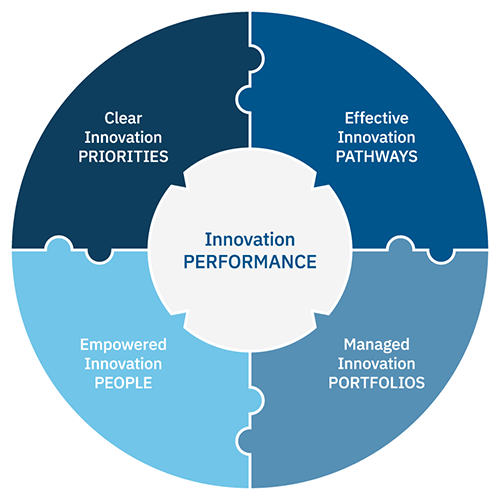
Innovation Performance Diagnostic Assessment

The first step in strengthening an organization’s innovation capabilities is to create a clear picture of how innovation is currently getting done, what’s working well and what’s getting in the way. Your answers to the following 15 questions will help paint a holistic picture about the relative strength of your innovation system across each of the five primary components of the innovation performance model — performance, clear priorities, effective pathways, managed portfolios and empowered people.
Begin Assessment
Your Time Is Valuable
With just a few questions, the entire assessment can typically be completed in less than 10 minutes.

Think
Differently
See how your score compares with your understanding of the current state of innovation at your organization.

Your Organization Is Complex
By answering each question honestly, you’ll get a feel for your team’s strengths and opportunities.

Plan
Differently
Evaluate your organization’s areas of strength and opportunity to craft a plan for improvement.

You Need Results Fast
Receive a personalized report, including your results and suggested next steps.

Act
Differently
Get expert advice and targeted recommendations to improve your organization’s results quickly.
Note: Your maturity-level score was calculated based on your responses along a Likert scale (1-5).
Leaders who seek to understand their systems today and take steps to strengthen it across the five dimensions of innovation performance are investing in the engine that will help their organizations own the future."
| Overall Innovation Maturity Explained | |
| 1-2 | Initial By taking this assessment, you have proven that, although the initiative is in its infancy, innovation is a priority for you and your organization. Use the following report to glean insights and tactics you can use to enhance the foundation you’ve built. |
| 3-4 | Progressing Your organization has likely already invested a great deal of time and resources into developing innovation systems. Congratulations on your progress thus far. Use the following report to take your innovation program to the next level. |
| 5 | Optimized Congratulations on the success of your organization’s innovation systems. Based on your responses, your program is best in class and should be celebrated! Sustainability, though, can be a major barrier for even the most successful innovation programs. Use the following report to find ways to strengthen the long-term viability of yours. |
| Your Overall Innovation Maturity Score | 1-5 |
| Innovation Performance Maturity Score |
1-5 |
| Innovation Priorities Maturity Score |
1-5 |
| Innovation Pathways Maturity Score |
1-5 |
| Innovation Portfolios Maturity Score |
1-5 |
| Innovation People Maturity Score |
1-5 |
4 Innovation Performance
Innovation should always be a means to an end, not an end in itself. These goals will vary from one organization to the next, but defining them clearly is a precursor to building the right capability and being able to measure its effectiveness. For this reason, innovation performance is at the center of the model. Specifically, an organization must clarify and align on two types of performance for innovation:
Desired performance outcomes:
Lagging measures that correspond to the business results the organization is trying to achieve from innovation
Leading system indicators:
Leading measures that help to identify whether the business is on track to achieve desired results
| 1-2 | Your maturity score indicates that you are in the beginning stages of your innovation performance journey. As a start, consider working with senior leadership to identify and align around common enterprise goals for your innovation system. |
| 3-4 | You appear to have a well-established innovation program. To maintain your progress, ensure that you are tracking the right metrics. To identify appropriate metrics, it is helpful to work backward from the desired performance outcomes and ask the question "What needs to be true to be on track to achieve them?" |
| 5 | Your score indicates that you have a very strong innovation performance program and are probably already tracking a number of related key performance indicators (KPIs). Regardless of the specific metrics tracked, be careful to focus on the few that matter and avoid the twin traps of metric proliferation (tracking too many metrics simultaneously) and vanity metrics (tracking easily achievable measures that deliver a false sense of progress). |
2 Innovation Priorities
We often hear managers assert they do not want to constrain their innovation teams. However, our experience suggests the highest-performing teams are those that are given “just enough focus” to ensure they work on the most valuable ideas, while still giving them ample flexibility to explore creative new approaches to achieving that impact. Clear innovation priorities require:
Common innovation language:
to ensure everyone in the organization understands what types of innovation are pursued and why
Strategic focus areas:
to guide innovators toward problems aligned with strategy.
Clear innovation boundaries:
to frame what types of innovation are most desirable and which are out of bounds.
Dynamic priority management:
to ensure priorities adapt over time in response to changing customer needs or competitive threats.
| 1-2 | Your score in this area suggests that your organization may not have clearly defined innovation priorities. If that is the case, get started on the path to standardization by creating a common enterprise innovation language, specifically related to the types of innovation the organization seeks to produce. There will inevitably be more than one kind that is strategically important for any organization, so it is essential to define — with precision — multiple distinct innovation types. |
| 3-4 | At this stage of your journey, it is important to maintain momentum and double down on strategic prioritization. To eliminate rework and limit frustrations, set up clear guardrails for the types of ideas that are desired, discussable and out of bounds based on their alignment (or lack thereof) to the larger organizational strategy. You may find it helpful to develop a goals-and-bounds table to capture project-level constraints. |
| 5 | You have optimized innovation priorities in your organization. To sustain momentum, ensure the innovation priority management function is owned and managed by a specific corporate or business unit team (typically strategy or innovation) and that guiding principles are refreshed annually as part of the organization’s strategic planning efforts. |
3 Effective Pathways
An innovation pathway is the set of steps an innovation takes from initial idea to implementation. Innovation pathways exist in all organizations and can be formal, informal or somewhere in between. The key is to ensure all pathways are intentional, explicit and optimized to the type of innovation they are intended to produce. Specifically, effective innovation pathways require:
Explicit pathway architecture :
to ensure each type of innovation is supported by the system.
Optimized pathway operations :
customized to each type of innovation.
Constructive pathway governance:
to frame what types of innovation are most desirable and which are out of bounds.
| 1-2 | It can be helpful to begin this process by answering honestly the following questions:
|
| 3-4 | At this point in your journey, mapping your organization’s pathways will be a valuable exercise to provide a clear view of what is truly driving progress against performance outcomes (e.g., pipeline throughput or pipeline value) — information that can feed directly into the design of optimized pathway operations. |
| 5 | Even the best-designed pathways can fail to get results. When this happens, the culprit is often ineffective pathway governance. High-performing organizations take a systematic approach to adapting inefficient processes and, where needed, create new processes (often as simple as direct access to a key functional team member in the appropriate human resources or legal team) to ensure teams have appropriate and timely support. |
3 Managed Innovation Portfolios
One of the biggest challenges in a large organization is the need to manage not just individual innovation projects but also the aggregate portfolio of projects. After all, it is this collective set of projects, drawing from the same pool of resources, that together will achieve the organization’s desired performance outcomes. Leaders need visibility into these portfolios so they can answer management questions about them, strategically balance resources across them and manage them dynamically over time. Managed innovation portfolios require:
Strategic portfolio plans :
to ensure leaders are focused on the most critical projects that need to be assessed and managed, not just individually but collectively.
Actionable portfolio insights :
that ensure leaders have ongoing visibility into portfolio-level performance and can use this knowledge to make strategy and resource allocation decisions.
Integrated portfolio management :
to ensure portfolio considerations are built into the core operations of the organization.
| 1-2 | At this stage, leaders should align on inclusion criteria for each portfolio and create a plan that considers:
|
| 3-4 | To support portfolio review conversations, it is helpful to develop multiple “portfolio views” that provide insight into organizational innovation efforts from different vantage points. These dashboards help leaders quickly identify red flags, bottlenecks, redundancies or opportunities to optimize resources across projects. |
| 5 | The most advanced organizations systematically include portfolio views in quarterly business reviews and upfront conversations during strategic planning to ensure leaders are making informed decisions about how best to invest to drive growth. There are three central questions to discuss in these reviews:
|
3 Empowered People
Strong talent can often compensate for failures within the rest of the innovation system, but this is not a long-term solution as it can lead to burnout as well as morale and retention issues. Organizations can sustainably empower their innovation people by investing in:
Effective innovation talent:
enabled by approaches to hiring, staffing, development and performance management specifically tailored to innovators.
Inspiring innovation leaders:
who model innovation skills and behaviors that are explicitly defined and supported by development programs and incentives.
A supportive innovation culture:
that helps innovation practitioners and leaders achieve their goals.
| 1-2 | Organizations that are successful at attracting and nurturing innovators are explicit about how they support them at every stage of the employment life cycle. These organizations:
|
| 3-4 | Organizations that are successful at attracting and nurturing innovators are explicit about how they support them at every stage of the employment life cycle. These organizations:
|
| 5 | It is the job of executives and their HR partners to nurture innovation leaders who can then inspire the rest of the organization. The top organizations do this, in part, by recruiting leaders who demonstrate the underlying capabilities to be successful. Even more importantly, they support internal leadership development activities (both formal and informal) by focusing on opportunities to create executive alignment. Organizations can empower leaders by creating ample space for them to participate in company strategy, ensuring alignment and a sense of ownership in the decisions they will be held accountable for delivering against. |
